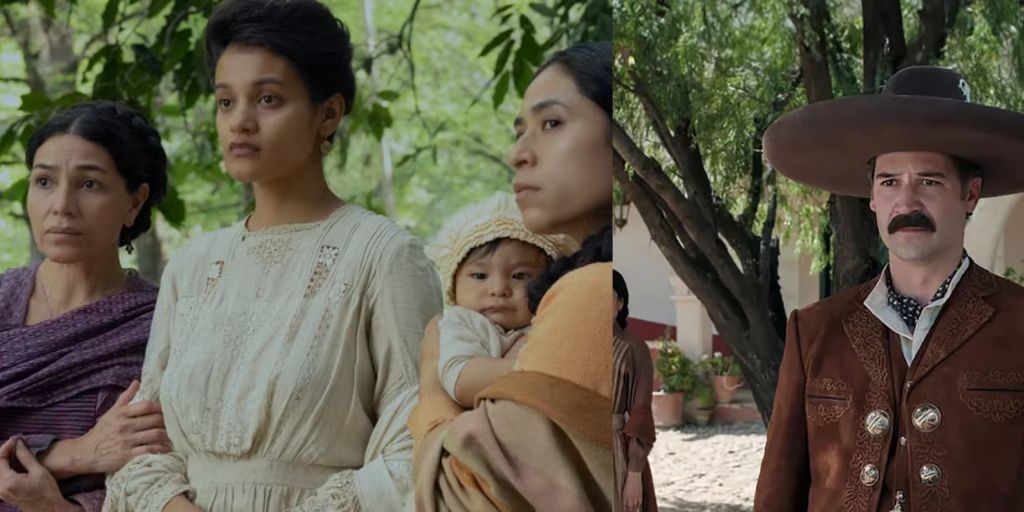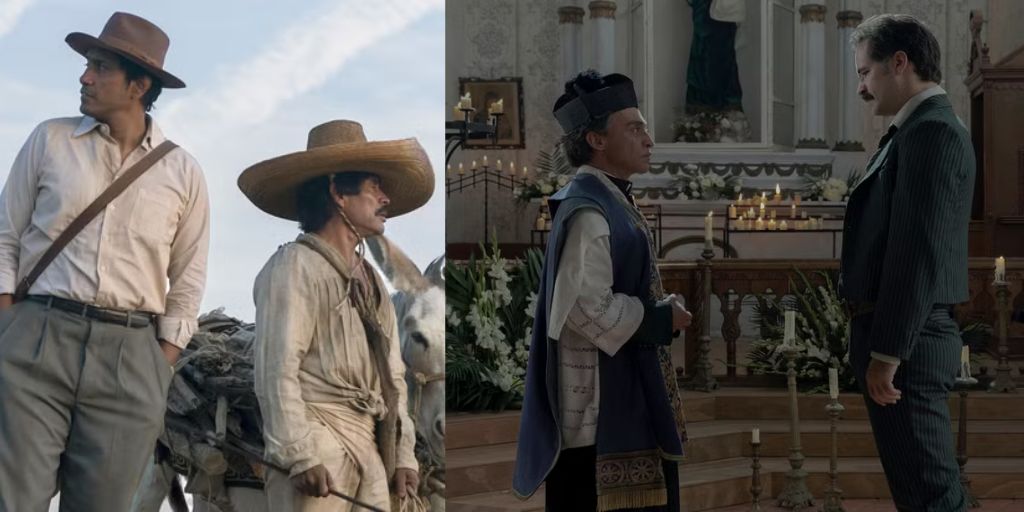Pedro Páramo is a film that stands out in how it shows the boundaries between life and the afterlife. While many films use the idea of life after death in their storytelling, few do so in a way that feels as innovative and intriguing as this one.
The film uses its supernatural elements not only to tell a attractive story but also to comment on the consequences of collective wrongdoing.
It’s an ambitious narrative that tackles multiple themes while managing to keep the viewer engaged without losing the plot.
The movie is based on the 1955 novel by Mexican author Juan Rulfo, which is considered one of the most important works of Latin American literature. It tells the story of Juan Preciado, a man who travels to a desolate town in search of his father, Pedro Páramo.
What begins as a simple search for his missing father turns into a deep view into the supernatural. As Juan confronts the truths about his father, he also begins to understand his own fate, moving between the past, present, and a limbo-like afterlife.
The film’s ability to blend timelines and its handling of the afterlife, or limbo, create a unique experience that attracts viewers.
Juggling Multiple Timelines Without Confusion
One of the standout features of Pedro Páramo is how it handles multiple timelines. The film takes on the challenge of presenting not just one story but several, all unfolding in different time periods.
At first glance, it might seem difficult for a film to manage this complexity without confusing the viewer. However, director Rodrigo Prieto, making his feature film directorial debut, does so with remarkable success.
Prieto uses a narrative technique that places complete trust in the audience’s ability to understand the shifting time periods.
Instead of using obvious tools, such as color grading or heavy visual cues, to mark the different timelines, the film relies on subtle changes.
Makeup, for example, is used to show characters at different ages. The use of younger and older versions of characters allows the audience to easily recognize the passing of time without being hit over the head with it.
The film’s ability to switch between different timelines without losing clarity is impressive.
There is a fine balance here, as the audience must be able to understand where and when each scene takes place. The subtlety of these transitions ensures the viewer is never confused.
It’s easy to follow the story even as it weaves through past, present, and an afterlife world. This approach is a refreshing change from other films that often rely on color schemes or specific visual effects to distinguish different time periods.
Prieto also manages to introduce the supernatural setting of the film in a gradual way. Instead of overwhelming the audience with all the information about the afterlife and its rules at once, the film takes its time.
New elements are introduced little by little, allowing the audience to get accustomed to the world of limbo and the eerie atmosphere that comes with it. The careful pacing of this transition helps keep the story fresh and engaging.
A Genre-Bending Film
As the film moves forward, it becomes clear that Pedro Páramo is not simply a supernatural story. It blends different genres, creating a unique viewing experience.
The narrative feels like a mix of Western, drama, and horror. The film also shifts in tone, from a mystery about a man searching for his father to a more philosophical meditation on life, death, and the consequences of actions.
The transition into the afterlife, which is central to the story, is handled in such a way that it feels like a genre-bending adventure. The supernatural elements don’t overpower the film but rather add to its complexity.
The movie’s atmosphere constantly shifts between tension, mystery, and surreal horror, all while remaining deeply philosophical.
This mix of genres adds depth to the film and makes it stand out from typical supernatural films that follow a more traditional narrative structure.
The cinematography plays a huge role in this shift. The visual changes in the movie reflect the changing tone, making it clear that the afterlife is not just another setting but an essential part of the story. The eerie, dreamlike quality of the afterlife world is enhanced by Prieto’s skillful cinematography.
As a renowned cinematographer for Martin Scorsese, Prieto’s expertise in creating atmosphere through visuals is on full display here.
He and his co-cinematographer, Nico Aguilar, work together to create an unsettling, haunting look that perfectly complements the film’s themes.
Cinematography That Speaks Volumes
The cinematography of Pedro Páramo is another reason why this film feels unique. The visuals are not just there to look good but to tell the story in ways that words cannot.
The cinematography highlights the dark, ominous nature of the town and the consequences of its past. The desolate, ghostly town is not just a backdrop but a character in itself. It is a reflection of the collective sins of the people who lived there, and the visuals make this clear.
In the opening scenes, the audience is placed in the perspective of Juan Preciado. This point of view helps the audience feel as confused and disoriented as the character does.
Juan doesn’t know where he is or what is happening, and the viewer is in the same position. This technique allows the audience to experience the strange and unsettling world of Pedro Páramo through Juan’s eyes, building empathy and understanding.
As the film progresses, the town and its people begin to reveal their darker nature. The setting becomes more unsettling, and the supernatural elements take on a stronger presence.
The eerie atmosphere is created not just through the story but through the visuals, which highlight the decaying, otherworldly nature of the town.
The afterlife is depicted as a bleak, sorrowful place, where the sins of the past haunt those who are stuck there.
The cinematography works in perfect harmony with the narrative, helping to establish the themes of fate, consequence, and the lasting effects of evil actions.
A Powerful Story, With A Flawed Execution
While the film does many things well, it’s not without its flaws. One of the biggest issues with Pedro Páramo is its pacing. At times, the film feels slow, especially when it moves from one part of the story to another.
For a movie that covers so much ground, it can sometimes feel surprisingly stale, especially in scenes where the audience is trying to keep track of the many characters and events.
The film introduces several characters throughout the story, and while each one has a purpose, it can sometimes be difficult to keep track of who they are and what role they play.
The story shifts between characters and timelines, and while the transitions are handled well, the sheer number of characters and plot points can occasionally be overwhelming.
This can make it hard for the audience to stay fully engaged, as it can feel like the story is moving too slowly or jumping between too many different storylines.
Another flaw of the film is the lack of focus on the female characters. While the male characters, especially Pedro Páramo, are given depth and complexity, the women of the story are often sidelined. The film does little to show their inner lives or motivations.
In many ways, the female characters are defined by their relationships to the men in the story, and their voices are not fully heard.
This is a missed opportunity, as these characters could have added a richer layer to the story. The film often treats women as mere plot devices, and while this is reflective of the social dynamics in the story’s setting, it’s still a flaw in the storytelling.
Themes of Power and Corruption
One of the central themes of Pedro Páramo is the abuse of power, especially in religious institutions. Pedro Páramo, the central character, is a man who has a ruthless, unyielding approach to life.
He’s the product of a town that has allowed its own moral decay to define its actions. Páramo’s role as a powerful figure in the town reflects a broader theme about the corrupting nature of power.
The film also critiques the way religious leaders can manipulate their power. Padre Rentería, the priest in the town, is shown as a man who makes decisions based on his own interests while claiming to act on behalf of God.

This character highlights the dangers of religious figures who use their influence to justify their own actions, leading to some of the most terrible consequences in the story. This theme is not unique to Pedro Páramo, but it is a key element in the narrative.
Pedro Páramo is a film that is both visually stunning and thematically rich. It tells a complex story that moves between different timelines and the afterlife while showing deep themes of power, fate, and the consequences of wrongdoing.
While the film has its flaws, such as pacing issues and the underdevelopment of its female characters, it is still a strong and engaging film.
Director Rodrigo Prieto proves that he is not only a master cinematographer but also a skilled storyteller. His work here makes us eager to see what he will do next.
Pedro Páramo is a haunting and thought-provoking film that leaves a lasting impact on its viewers.




